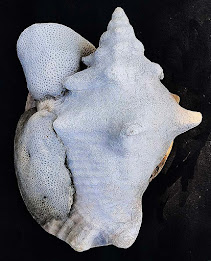The Buckhorn Asphalt Quarry (BAQ) in southern Oklahoma, USA, is a very rare occurrence of one of the oldest known mineralogically and chemically unaltered mollusk shells in the world. The rocks are Middle Pennsylvanian in age (about 310 million years old).
Aragonite is a common constituent of fossil and Recent mollusk shell. This biomineral is metastable and eventually recrystallizes into coarse-grained calcite, thereby destroying the original microstructures. There has been very little to no recrystallization of these kind of shells in the BAQ shells. The inner shell layers of many cephalopods (nautiloids and ammonoids), gastropods, and bivalves from the BAQ contain textures and microstructures identical to pristine, unaltered nacre of modern mollusks. Many shells have also their original Sr, Mg, and stable oxygen-isotope contents. Orthocone nautiloids have their original cameral deposits and conchiolin. Also, some gastropods have their original color patterns.
This exceptional preservation (also referred to as a “Lagerstatten”) occurred because either during or shortly after deposition, oil migration occurred along nearby wrench faults. This early incursion of oil prevented any diagenetic alteration to the BAQ shells and allowed for only pin-point cementation of the shell and sediment. Conversion of the oil to asphalt occurred later. When the asphalt is extracted via a Soxyhlet extractor (using dichlormethane) from the “rock,” the material crumbles under finger pressure.
The 10-m thick BAQ section of strata are mostly limestone (foraminifera-mollusk grainstones) in the lower part and a foraminifer-cephalopod coquina in the upper part. The strata overall consist of broken and abraded skeletal debris, scattered whole gastropod shells (some minute in size), scattered plant remains, and scattered micro-scour channels and cross beds. Many of the plant fragments and the orthocone nautiloids show preferred orientations. The shells were most likely winnowed by waves/currents in localized areas in a shelf environment affected by fluctuating depths.
My doctorate dissertation research at the California Institute of Technology concerned the first integrated geologic, paleontologic, and geochemical study of theBAQ. With the financial assistance of the Oklahoma Geological Survey, I arranged for the old (historic) BAQ to be reopened by means of two bulldozers, a back-hoe tractor, and two days of dynamiting. As a result, foliage and debris were removed, fresh bedrock was exposed, and the quarry proved to be approximately 168 m long, 25 m wide, and with an average depth of 7 m. A continuous 10-m-thick stratigraphic section was exposed near the west end of the quarry. The richest fossil bed of cephalopod remains was exposed for a distance of 38 m by means of the heavy machinery and precision dynamiting. This bed is richly asphaltic with dark black color and odor, and the abundant fossils had undergone no weathering whatsoever. In comparison, weathered rock (especially float) in the bottom of and along the south side of the quarry had a bluish-gray to gray color. Weathering became evident on freshly exposed asphalt even after a single rainstorm. The majority of the fresh bulk material I had uncovered during this excavation was either shipped or taken by me to southern California. A few years ago, I donated this material to the Invertebrate Paleontology Department of the Natural History Museum of Los Angeles County (LACMIP). Other material that I collected and gave to Caltech was later given to LACMIP. In order to facilitate future researchers visiting LACMIP to view all these samples, I recently donated to LACMIP my extensive collection of research papers concerning the paleontology and geology of the BAQ.
The way the quarry looked just after the dynamite process and bull-dozing were finished in 1970.
In addition to the mollusks, other fossils that I found in the BAQ strata are remains of land plants, foraminifera, chaetetid sponges, rugose corals, bryozoans, brachiopods, rare scaphopods and chitons, ostracods, and echinoderms.
Asphalt-impregnated straight (orthocone) nautiloid shell.
[For more details, see the reference: Squires, R.L. 1976. Color pattern of Naticopsis (Naticopsis) wortheniana, Buckhorn Asphalt Deposit, Oklahoma. Journal of Paleontology 50(2):349–350].
Since my reopening of the quarry back in 1970, many paleontologists, some from other nations, have visited the site and collected from the available material. Their studies have have revealed some new discoveries: algae, a rugose coral (rare), and isolated fish teeth and fish scales.
In a paper by Vendrasco et al. (2018) (cited below), I wrote a comprehensive summary of the geology of the BAQ and included pertinent references.
Vendrasco, M.J., A.G. Checa, R.L. Squires, and C.M. Pina. 2018. Unaltered nacre from the Pennsylvanian Buckhorn Asphalt, and implications for the arms race between mollusks and their predators. Palaios 33(16(:451-463).




















